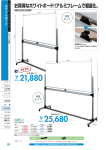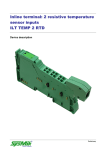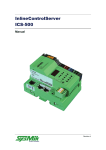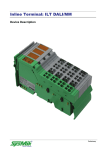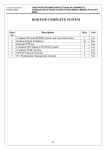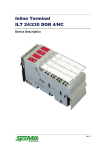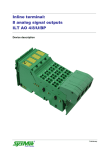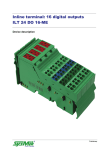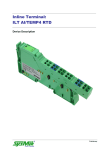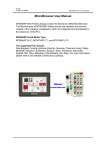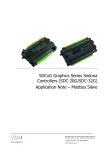Download Device description
Transcript
Scalibur – Modular Controllers SCA-340 / SCA-340-L Manual Revision 12 Disclaimer / Impressum This manual is intended to provide support for installation and usage of the device. The information is believed to be accurate and reliable. However, SysMik GmbH Dresden assumes no responsibility for possible mistakes and deviations in the technical specifications. SysMik GmbH Dresden reserves the right to make modifications in the interest of technical progress to improve our modules and software or to correct mistakes. We are grateful to you for criticism and suggestions. Further information (device description, available software) can be found on our homepage www.sysmik.de. Please ask for latest information. SysMik disclaims all warranties in case of improper use or disassembly and software modifications not described in this document or when using improper or faulty tools. Commissioning and operation of the device by qualified personnel only. All applicable regulations have to be observed. SysMik® and the SysMik logo are registered trademarks of SysMik GmbH Dresden. "Networking Together!"© is subject to copyright of SysMik GmbH Dresden. All other trademarks mentioned in this document are registered properties of their owners. These and further trademarks are used in this document but not marked for better readability. No part of this document may be reproduced or modified in any form without prior written agreement with SysMik GmbH Dresden. Copyright © 2015 by SysMik GmbH Dresden SysMik GmbH Dresden Bertolt-Brecht-Allee 24 01309 Dresden Germany 2 Tel Fax E-Mail (Sale) E-Mail (Support) Homepage sysmik.de + 49 (0) 351 – 4 33 58 – _0 + 49 (0) 351 – 4 33 58 – 29 [email protected] [email protected] www.sysmik.de Manual SCA-340 / SCA-340-L Contents Contents 1. Introduction 6 2. Device and System Overview 7 2.1 Hardware 7 2.1.1 Functional Overview 7 2.1.2 Processor Core 7 2.1.3 Ethernet 7 2.1.4 Serial Ports 7 2.1.5 USB 7 2.1.6 LON 8 2.1.7 Inline Local Bus Interface / Modular IO Terminals 8 2.2 Software Overview 9 2.2.1 Scalibur System Shell 9 2.2.2 IO Server 9 2.2.3 Commissioning Web Server 9 2.2.4 Sedona Virtual Machine 10 2.2.5 Niagara Framework 10 3. Installation and Commissioning 11 3.1 Assembly 11 3.1.1 Dimensions 11 3.1.2 Mounting 12 3.1.3 Adding Inline Terminals 13 3.2 Connections 14 3.2.1 Connectors 14 3.2.2 Power Supply 15 3.2.2.1 How to Connect Power 15 3.2.2.2 Power Dissipation Calculations for a Scalibur Controller 17 3.2.2.3 Current Consumption Calculation for a Scalibur Station (with Terminals) 18 3.2.2.4 Derating of Terminal and USB Supply 18 3.2.2.5 Protective Devices of 24 V Main and Segment Supply UM and US 20 3.2.3 RS-485 and LON 20 3.2.4 Ethernet 21 SCA-340 / SCA-340-L sysmik.de 3 Contents 3.2.5 USB-OTG for local Access 22 3.2.6 USB 23 3.3 Operating Elements 24 3.3.1 Overview 24 3.3.2 Inline Supply LEDs “US”, “UM”, “UL” 24 3.3.3 Process Status LEDs “PL”, “ST”, “SE” 24 3.3.4 IO Status LED “IO” 25 3.3.5 Communication LEDs “COM1”, “COM2”, “LON” 25 3.3.6 Service Button and LED “SV” 26 3.3.7 Ethernet Status LEDs 26 3.3.8 RS-485 Termination 27 4. Software 28 4.1 Configuration Tools 28 4.1.1 SCA System Shell 28 4.1.2 Comissioning Website 29 4.1.3 File Access via FTP 29 4.2 Comissioning Scalibur 29 4.2.1 IP Addressing 30 4.2.2 Time and Time Zone 30 4.2.3 Hardware Data Point Test 30 4.3 Real-Time Control with Scalibur and Sedona 31 4.3.1 IO Access 31 4.3.2 Modbus 32 4.3.3 Platform Service 32 4.4 Integration with Scalibur and Niagara Framework 33 4.4.1 Local IO Access 33 4.4.2 Serial Interfaces 34 4.4.3 IO Remote Control 36 4.4.4 Sedona Integration 37 4.5 Concurrent Access to the IO Terminals 37 5. Best Practices and Troubleshooting 39 5.1 Performance and Resource Management 39 4 sysmik.de Manual SCA-340 / SCA-340-L Contents 5.2 Reliability of Nonvolatile Memory 39 5.3 Diagnosis and Troubleshooting 39 5.3.1 SCA System Shell / Comissioning Website is not accessible 40 5.3.2 IP Address unknown 40 5.3.3 No IP Communication 40 5.3.4 Unknown Niagara Platform Access Credentials 40 5.3.5 Sedona Virtual Machine is not Starting 40 5.3.6 IO Errors 41 6. Technical Data 42 7. Order Information 45 7.1 Scalibur and Accessories 45 7.2 Supported Inline Automation Terminals 46 8. Glossary 48 9. Third-Party Software 49 10. Bibliography 49 SCA-340 / SCA-340-L sysmik.de 5 Introduction 1. Introduction Scalibur is a powerful modular controller for Niagara and Sedona. Scalibur stands for scalability, a major characteristic of this controller. Scalability comprises several aspects: 1) Scalable IO A Scalibur station consists of the Scalibur controller and up to 63 terminals of the modular Inline system. The terminals are available in a wide variety of types: digital and analog inputs and outputs with different numbers of channels as well as functional terminals for DALI light control, pulse metering, MBUS or serial interfaces. 2) Scalable software Scalibur has been developed primarily for the Niagara AX framework. While Niagara AX is extremely powerful, it is not very well suited for real-time applications. In order to realize such applications with Scalibur too, the Sedona framework has been ported to Scalibur. Sedona applications run with fixed cycle times in the millisecond range. Niagara station and Sedona application are created with the same engineering tool – “Workplace AX”. Beside the separate exclusive use of either framework, the parallel use of Niagara AX and Sedona with seamless integration of the Sedona data points in Niagara AX is also supported. 3) Scalable licensing The license model for Scalibur is very flexible: a license comprises a certain number of devices and data points which are integrated with Scalibur. These license packs contain 50 data point licenses per device license and are available as first-time license (5/10/25/100/200 devices) or as upgrade license (10/25/50 devices). Sedona, as open source project, doesn’t have any license fees. 4) Scalable IP network Scalibur contains two logically separated IP interfaces and an integrated Ethernet switch with four external ports. The configurable assignment of the Ethernet ports to the separate IP interfaces and the usage of the spanning-treeprotocol 1 allows flexible topologies like daisy-chain and redundant ringstructures for both the backbone and the local control network. 1 available Q1 / 2016 SCA-340 / SCA-340-L sysmik.de 6 Device and System Overview 2. Device and System Overview 2.1 Hardware 2.1.1 Functional Overview Fig. 2.1.1.1: SCA-340-L basic circuit diagram 2.1.2 Processor Core 2.1.3 Ethernet 2.1.4 Serial Ports 2.1.5 The processor core is made up of a 1 GHz ARM Cortex A8 CPU, 512 MiB RAM, 1,8 GB Flash, 512 KiB SRAM and an RTC. SRAM and RTC are buffered for a power failure of 5 days. The internal Flash memory can be extended with a microSD card. The integrated Ethernet switch has 4 external ports, which can be assigned independently to one of the two separate IP interfaces. By default (delivery), en0 is assigned to LAN3 and LAN4, and en1 with LAN1 and LAN2. Both RS-485 ports have switches for bias and terminating resistors, and are galvanically isolated from each other and the rest of the circuit. Further serial interfaces may be added using modular IO terminals (M-Bus, RS-232, RS-485, RS-422). USB USB 1 is a USB-OTG port with Mini-USB socket, and is used for installation and maintenance. Connected to a PC, it allows to control the device via console and to access the internal installation web site for device configuration and data point test. SCA-340 / SCA-340-L sysmik.de 7 Device and System Overview The second USB port (USB 2) allows to connect USB end-devices. 2.1.6 LON 2.1.7 Inline Local Bus Interface / Modular IO Terminals 8 The SCA-340-L has a LON interface according to the CEA-709 standard, to connect directly to LonMark TP/FT-10 networks. The local bus interface allows to connect up to 63 modular IO terminals. This interface comprises the communication channel to the IO terminals as well as the power supply of these terminals and their connected sensors and actuators. Scalibur is a controller for the Inline IO system and unlocks the rich pool of Inline IO terminals for building automation. Inline is a modular IO system by Phoenix Contact, to flexibly and quickly build up space-saving automation stations. An Inline station consists of a bus controller and a set of IO terminals, chosen freely in terms of numbers, type, and sequential arrangement. The bus controller runs the Inline station and has interfaces to the higher level controller. Up to 63 IO terminals can be connected to a bus controller. There are IO terminals for almost any purpose: digital inputs and outputs with 1, 2, 4, 8, 16, or 32 channels per terminal Triac and relay outputs for switching signals or for higher loads analog inputs for measuring voltage, current, resistance, or temperature with 2, 4, or 8 channels per terminal analog outputs for voltage or current with 2, 4, or 8 channels per terminal function terminals for complex IO operations or gateway functions (DALI, M-Bus, S0 pulse metering, serial interface) supply and support terminals , e.g. to realize separated voltage domains within an Inline station The overall width of the Inline extension terminals is 1, 2 or 4 DU (1 DU, division unit = 12.2 mm or approx. 0.48 in.). Inline terminals are provided with a pluggable wiring level enabling pre-wiring and easy module exchange. The mechanics of the system also allows exchanging terminals without complete dismantling of the station. Scalibur determines type and function of all supported terminals automatically, thus certain in- and output functions can also be created without a previous configuration of the station, which is especially helpful for commissioning tests. sysmik.de Manual SCA-340 / SCA-340-L Device and System Overview 2.2 Software Overview Scalibur is using a Linux operating system, which runs several applications in parallel. Fig. 2.2.1: Scalibur software structure 2.2.1 Scalibur System Shell The Scalibur System Shell is accessible only via the local USB-OTG port, and is used during comissioning to configure basic settings like IP address, or as maintenance access if IP address or passwords have been lost. 2.2.2 IO Server 2.2.3 Commissioning Web Server The IO server controls the modular Inline terminals of the Scalibur station and manages concurrent accesses to the hardware data points. Niagara and the IO server communicate via an TCP connection. This allows to control IOs remotely from another Niagara station. The remote access can be limited or disabled by the setting of the IP address of the controlling station. The commissioning web server is exclusively accessible via the local USB-OTG port. It presents web pages to commission the device: setting IP addresses and time zone, reading state of inputs and setting output states of the data points of the local IO terminals for test purposes. SCA-340 / SCA-340-L sysmik.de 9 Device and System Overview 2.2.4 Sedona Virtual Machine 2.2.5 Niagara Framework 10 The Sedona virtual machine (SVM) runs the Sedona application in real-time with configurable cycle time. The engineering tool Workplace AX connects to the SVM to modify the application, load updates, or create backups of the application. Platform specific kits provide access to the IO terminals, and also to system settings like IP addresses and Modbus settings. A Modbus TCP server and a Modbus TCP client/Modbus RTU master are integrated and are used to exchange data with other Sedona controllers. Also, Niagara can be deactivated here. Scalibur can be parameterized with Workplace AX and a platform connection to the Niagara daemon. This includes loading of software updates and of a station (Niagara application), which can be run automatically by the Niagara daemon. A Workplace AX connection to a station is used to modify the station. All features of the Niagara framework are available: data point integration over a plethora of open automation protocols (LON, BACnet, M-Bus, Modbus, and others) with data normalization system functions (scheduler, alarming, trend log) web visualization enterprise interfaces (oBIX, data bases) and many more sysmik.de Manual SCA-340 / SCA-340-L Installation and Commissioning 3. Installation and Commissioning 3.1 Assembly 3.1.1 Dimensions Width x Height x Depth: 80 mm x 119,8 mm x 71,5 mm (3.15 inch x 4.72 inch x 2.81 inch) Fig. 3.1.1.1: Scalibur dimensions SCA-340 / SCA-340-L sysmik.de 11 Installation and Commissioning 3.1.2 Mounting Preferred mounting position is horizontal (i.e. on a horizontal DIN rail which is attached to a vertical wall). For all other mounting positions, a derating has to be observed (see chapter 9). Note: The air vents have to be kept free with a sufficient spacing to other components, to ensure optimal air ventilation. The device is designed for easy snap in mounting on 35 mm x 7.5 mm DIN EN 60715 rails (formerly DIN EN 50022). Note: The DIN rail should be attached to a mounting plate or an even back plane for best stability. Suitable fixtures, like end clamps or grounding terminals have to be used at both ends of the station, to prevent sliding off the rail. Note: To ensure easy unlocking of the Ethernet connectors, use only clamps at the bus controller side of the station that do not protrude more than 30 mm from the rail. Note: Only use clean and corrosion free mounting rails in order to ensure a safe contact between the FE terminals. 12 sysmik.de Manual SCA-340 / SCA-340-L Installation and Commissioning 3.1.3 Adding Inline Terminals An Inline station is assembled by plugging the individual components to each other, thus establishing the potential and bus signal connection between the individual components of the station. Figure 3.1.3.1 shows the procedure of mounting a terminal. Disconnect power to the entire station. Mount the electronics base onto the rail (A). Adjacent terminals are interlocked by their feather keys / keyways (B). First insert the feather keys of the local bus into the keyways of the preceding terminal (B1). Guide the feather keys along the keyways until they lock appropriately (B2). Ensure that the feather keys are properly connected (C2). C1 shows the common mistake that the feather keys are not inside their keyways. After mounting all electronics bases install the connectors onto their respective bases. First insert the front detent (D1). Then push the connector onto the electronics base until the rear detent locks properly (D2). 6452B010 Figure 3.1.3.1: Installation on the mounting rail (A), connection of Inline components to each other (B), connection check (C), plugging of the wiring level (D) Note: While connecting the components to each other and to the mounting rail later, please make sure that all feather keys and latches are properly snapped in! Note: Please consult the User Manual with regard to configuration and installation of the Inline product family (see [3]). SCA-340 / SCA-340-L sysmik.de 13 Installation and Commissioning 3.2 Connections 3.2.1 Connectors 1 2 Micro-SD card slot 8 Switches for RS-485 termination / bias Type label with device-specific 9 Service interface information 3 Service button 10 Bus interface connector 4 Ethernet (4x 10/100BaseT) 11 Supply connector 5 FE connector *) 12 Labeling field (2x) 6 USB 1 (mini USB, USB-OTG) 13 Diagnostic indicators 7 USB 2 14 End plate *) … The FE connector is placed at the rear side of the controller – it is not visible in the sketch. Fig. 3.2.1.1: Overview device connections 14 sysmik.de Manual SCA-340 / SCA-340-L Installation and Commissioning 3.2.2 Power Supply 3.2.2.1 How to Connect Power The bus controller is operated with 24 V DC. The bus controller is powered from this source and it generates the logic voltage for the logic circuit and the analog voltage for the analog circuit. The logic circuit supplies the internal bus including the communication chips of all connected automation I/O terminals. The analog circuit provides an auxiliary supply for analog signals. Note: While connecting the automation terminals please observe the derating of the logic voltage, the supply of the analog terminals, and the maximum ampacity of the terminals. Furthermore the bus controller includes connections for the supply of the mains and segment voltage of the Inline station. Fig. 3.2.2.1.1 shows the basic circuit for the connections of the power supply. Fig. 3.2.2.1.1: Supply of UM / UBK and US from different sources (A) and from a common source (B) Note: If UBK/UM and US are to be supplied from a common source, the fuse protection of the individual sections with regard to their supply requirements has to be observed. Note: The current passing through terminals and potential routing contacts must not exceed 8 A. The Functional Earth ground FE is connected to the potential routing contacts and is automatically grounded if the bus controller is snapped on a grounded mounting rail. The function of FE is to discharge interferences. SCA-340 / SCA-340-L sysmik.de 15 Installation and Commissioning Note: Functional earth ground (1.4 and. 2.4) has to be connected additionally via 1.5 mm² wire (AWG 15) and grounding terminal to the mounting rail (see Fig. 3.2.2.1.2). Fig. 3.2.2.1.2: Connecting functional earth ground (FE) of Scalibur 16 sysmik.de Manual SCA-340 / SCA-340-L Installation and Commissioning Terminal point Name 1.1 US 2.1 1.2, 2.2 UBK / UM 1.3, 2.3 GND 1.4, 2.4 FE Function 24 V DC segment supply (segment circuit); The supplied voltage is lead to the automation terminals via the potential routing contacts. UBK: 24 V DC bus controller supply, logic supply (UL) and analog supply (UANA) UM: 24 V DC main voltage (main circuit); The supplied voltage is lead to the automation terminals via the potential routing contacts Reference ground for the internal bus and automation terminals (logic and analog circuit) and for the main and segment supply (main and segment circuit). Functional ground; Connecting the functional ground to this terminal point is mandatory (see above). The terminal point is internally connected to the potential routing contacts and the FE contact at the back side of the enclosure. Table 3.2.2.1.1: Terminal assignment of supply connector 3.2.2.2 Power Dissipation Calculations for a Scalibur Controller The power dissipation of the bus controller equals the sum of the power requirements of the bus controller itself and the power loss of the internal power supply for the whole Inline station: PSCA = PO + PUSB + PPERI PSCA PO PUSB power dissipation of the bus controller power requirements for operating the bus controller without terminals and any external load (4.1 W) power dissipation of the bus controller caused by the load on USB1 and USB2 (max. 500 mA each) PUSB = 0.7 V × ( IUSB1 + IUSB2 ) PPERI power dissipation of the bus controller caused by the Inline IO terminals PPERI = 1.0 V × IL IL current consumption of UL Note: The factors 1.1 V und 0.7 V result from the electrical efficiency of the internal power supply unit. Sample calculation: Power dissipation of a Scalibur in case of the maximum possible current drawn from UL and a USB memory stick with 0.1 A current consumption. PSCA = 4.1 W + 0.7 V × 0.1 A + 1.0 V × 2.0 A PSCA = 4.1 W + 0.07 W + 2.0 W PSCA = 6.17 W SCA-340 / SCA-340-L sysmik.de 17 Installation and Commissioning 3.2.2.3 Current Consumption Calculation for a Scalibur Station (with Terminals) To find a suitable external power supply, the current consumption of the entire Scalibur station has to be considered: IIS = ISCA + IUSB + IK + IAS current consumption of the entire Scalibur Inline station current consumption of the Scalibur current consumption of connected USB devices current consumption of connected terminals current consumption of sensors and actuators, fed by the Inline station The current consumption of a Scalibur (without terminals) is maximum 170 mA. ISCA = 0.17 A Please consult the manual of the connected USB device to find out the actual current draw from USB. The respective USB currents IUSB1 and IUSB2 are weighted by a factor of 0.24, resulting in the equation: IIS ISCA IUSB IK IAS IUSB = (IUSB1 + IUSB2 ) × 0.24 The current consumption of the connected terminals can be found in their manuals. The following rules of thumb apply: The current provided by UANA influences the total current directly. The current provided by UL applies to the total current with a factor of 0.36. The following formula applies: IK = IA + IL × 0.36 IA current from UANA (max. 500 mA) IL current from UL (max. 2.0 A) See the according datasheets in order to determine the current consumption of the connected actuators and sensors. For an estimation it is often sufficient to check, whether the supply can be provided completely by the Scalibur, that is without power or boost terminals. Without power and boost terminals and regardless of the circuits UM und US, the maximum current consumption of the Scalibur with connected terminals is 1.7 A. In addition there are the current requirements of the sensors and actuators, whereas the current through feather keys and keyways is limited to a maximum of 8 A. Note: When selecting an external power supply, plan sufficient reserves. also into account that it could come to a current increase to a multiple of the rated current in the moment of turn-on caused by input capacities. Power supplies with over current shut-down must have a sufficient response delay to avoid start-up problems. 3.2.2.4 Derating of Terminal and USB Supply Because USB and the Inline terminals are supplied by Scalibur’s internal power supply unit, an increased load there increases Scalibur’s internal power dissipation., Therefore, a derating has to be observed, which is depending on the mounting position (see Fig. 3.2.2.4.1). The recommended mounting position (with least derating) is horizontally (that is, clipped to a horizontal DIN rail on the wall). 18 sysmik.de Manual SCA-340 / SCA-340-L Installation and Commissioning The internal power dissipation caused by USB loads (PUSB) and the connected Inline terminals (PPERI) is calculated according to chapter 3.2.2.3. Pv [%] 100 80 horizontal mounting 60 other mounting positions 40 20 0 -25 -15 -5 5 15 25 Pv [%] Power dissipation of internal Scalibur supply in % Tenv [°C] environmental temperature in °C 35 45 55 Tenv [°C] Fig. 3.2.3.2.1: Derating diagram of maximum internal power dissipation Please refer to the manuals of the Inline terminals to find out the load of the logic supply. Maximum load on the logic supply (2 A) and on USB (2 x 500 mA) leads to a 100% power dissipation of 2.7 W: PV = 1.0 V × IL + 0.7 V × IUSB PV = 1.0 V × 2.0 A + 0.7 V × 1.0 A = 2.7 W This power dissipation can be maintained up to a maximum environmental temperature of 40 °C (104 °F). For higher temperatures, the load (PPERI and PUSB) must be reduced according to Fig. 3.2.2.4.1. Example 1: Horizontal mounting position For an environmental temperature of 55 °C (131 °F) and horizontal mounting, the power dissipation is limited to 87 %, which means 2.35 W. Supposed IL is fully loaded with the max. allowed 2 A, then the USB ports can support a maximum of 0,5 A: 0.87 PV – 1 V × IL 0.7 V 2.35 W – 2 W = = 0.5 A 0.7 V IUSB = IUSB SCA-340 / SCA-340-L sysmik.de 19 Installation and Commissioning Example 2: Other mounting positions For an environmental temperature of 45 °C (113 °F) and non-horizontal mounting, using additionally a USB device with 200 mA, the power dissipation is limited to 70 %, i.e. 1.89 W. Therefore, the max. current from UL is: 0.7 PV – 0.7 V × IUSB IL = 1V 1.89 W – 0.14 W IL = = 1.75 A 1V 3.2.2.5 Protective Devices of 24 V Main and Segment Supply UM and US Surge / overvoltage: Input protective diodes (can be destroyed by permanent overload). Polarity reversal: Parallel diodes. In case of wrong polarity a high current is flowing which is blowing the external fuses. Segment supply and main supply are related to the same ground potential. Note: Each 24 V voltage supply must be fused externally. The power supply unit must be capable of supplying a current four times the nominal value of the external fuse to reliably blow the fuses in case of an error. 3.2.3 RS-485 and LON The interface connector provides terminals for both RS-485 interfaces and (for SCA-340-L only) the LON TP/FT-10 interface. Fig. 3.2.4.1: RS-485/LON Interface terminal connections 20 sysmik.de Manual SCA-340 / SCA-340-L Installation and Commissioning Terminalpoint 1.1 1.2 1.3 2.1 2.2 2.3 1.4 2.4 Name Function COM1 + COM1 SH1 COM2 + COM2 SH2 NT1 NT2 COM1 RS-485 data signal + positive COM1 RS-485 data signal - negative COM1 shield COM2 RS-485 data signal + positive COM2 RS-485 data signal - negative COM2 shield LON TP/FT-10 (SCA-340-L only), polarity independent Fig. 3.2.4.2: Terminal assignment of interface connector For RS-485 the proper polarity has to be observed, and bias and termination resistors have to be chosen properly. Scalibur has fitting built-in-resistors, which can be used via DIP switches. The shield connections are internally capacitive connected to FE (functional earth). The connection is pluggable and includes two terminal points connected inside the plug for each bus line. Thus the TP/FT-10 bus can be wired in one line without additional terminals and the ICS can be removed without bus interruption. While connecting LONWORKS technology based devices to the bus, the LONMARK wiring guidelines [3] must be observed. According to the network topology one or two network terminators such as SysMik ACC-BT have to be attached. If shielded cables are used, the shield can be connected to the SH connector in order to avoid electrostatic charging. The data bus is polarity independent. More detailed information can be found in the manual of the used transceiver [2]. 3.2.4 Ethernet The Scalibur provides four Ethernet interfaces with built-in switch and the following properties: shielded RJ45 connectors 10/100BaseT, automatic detection automatic MDI/MDI-X crossover detection Pin1 RD+ Pin2 RDPin3 TD+ Pin4 not used Pin5 not used Pin6 TDPin7 not used Pin8 not used Figure 3.2.5.1: Terminal assignment of Ethernet connector SCA-340 / SCA-340-L sysmik.de 21 Installation and Commissioning The 10/100BaseT-Ports are able to recognize and to correct an interchanged receive path pair (RD+/RD-). Thus either crossover or patch cable can be used, no matter if the remote station is another end device, a switch or a hub. Note: The maximum distance of 100 m between Ethernet devices can only be achieved using cables from category 5 on. 3.2.5 USB-OTG for local Access The local access is a connection between Scalibur and a PC, which works regardless of the device settings (especially IP address). Simply connect a Windows PC to the Scalibur with a standard Mini USB cable. Installation of PC driver If you connect the Scalibur to your PC for the first time, Windows detects a new device and shows this in the Device Manager as “RNDIS/Ethernet Gadget” below “Other devices”. Now the proper driver has to be installed manually. select “Update driver software…” in the local menu of the device entry chose “Browse my computer for driver software” chose “Let me pick from a list of device drivers on my computer” select “Network adapters” as device type select “Microsoft Corporation” as manufacturer and “Remote NDIS Compatible Device” as network adapter and click “Next” pass warning “Update driver warning” with “Yes” close the notification window after successful device driver installation Fig. 3.2.6.1: Selecting device driver The Scalibur is now located under „Network adapter“ as „RNDIS/Ethernet Gadget“. This acts as additional network interface, which provides a local network access to the Scalibur. 22 sysmik.de Manual SCA-340 / SCA-340-L Installation and Commissioning 3.2.6 USB The USB type A socket accepts USB end devices according to the standard USB 1.0 and USB 2.0. Beside this, the device must also be supported by software (esp. driver). SCA-340 / SCA-340-L sysmik.de 23 Installation and Commissioning 3.3 Operating Elements 3.3.1 Overview Fig. 3.3.1.1: Front view with display and operating elements 3.3.2 Inline Supply LEDs “US”, “UM”, “UL” LED US UM UL State Description green voltage at segment circuit (+24 V DC) off no voltage at segment circuit green voltage at main circuit (+24 V DC) off no voltage at main circuit green UBK (24 V supply), UL (logic supply) OK off UBK, UL not OK Table 3.3.2.1: Inline supply LEDs 3.3.3 Process Status LEDs “PL”, “ST”, “SE” LED Description PL status of Niagara platform ST status of Niagara station SE status of Sedona Virtual Machine, incl. IO-server Table 3.3.3.1: Process status LEDs In normal operation, all three LEDs are using the same signalizing method. 24 sysmik.de Manual SCA-340 / SCA-340-L Installation and Commissioning LED status Description off The process has not been started. 10 % on time blinking yellow (2 s period) 50 % on time 90 % on time The process is running and needs less than 10 % of processor time. The process is running and needs between 10 % and 50 % processor time. The process is running and needs more than 50 % processor time. Table 3.3.3.2: Process status LED behavior During a software update, the process status LEDs signalize the programming process as a running light. 3.3.4 IO Status LED “IO” The communication state of the IO terminals is signalized by a dual colored “IO” LED, located at the supply connector. State Description off The IO server is not running. green Communication with Inline terminals is OK. yellow Communication with the Inline Terminals is not working. Possibly, there are no terminals attached or the terminals are not snapped-in properly. Table 3.3.4.1: IO status LED 3.3.5 Communication LEDs “COM1”, “COM2”, “LON” Located at the interface connector, the Scalibur has LEDs which signalize the data transmission of their respective interface. The layout of the LEDs resembles the layout of the terminals: COM1 upper left, COM2 upper right, and LON below (only SCA-340-L). Fig. 3.3.5.1: COM LEDs SCA-340 / SCA-340-L sysmik.de 25 Installation and Commissioning LED State Description COM1 Rx green Data are being received via COM1. COM1 Tx yellow Data are being sent via COM1. COM2 Rx green Data are being received via COM2. COM2 Tx yellow Data are being sent via COM2. LON Rx green Data are being received via LON (only SCA-340-L). LON Tx yellow Data are being sent via LON (only SCA-340-L). Table 3.3.5.1: Inline supply LEDs 3.3.6 Service Button and LED “SV” LED state Description off normal operation and for about 7 s after power-on red booting, approx. 7 s Time slice of about 2 s after booting; allows manual reset of IP address and Niagara platform access credentials to state of delivery. Time slice of about 2 s after red blinking; allows manual reset of blinking green 5 Hz Sedona application and kits to state of delivery. blinking red 5 Hz Table 3.3.6.1: Service LED How to reset IP address, access credentials, and Sedona The Service button can be used in interaction with the Service LED to manually reset IP address, Niagara platform access credentials, and Sedona to the state of delivery. If the Service button is pressed when the Service LED is blinking red, and is held pressed for at least 3 s, the IP address of eth0 and the Niagara platform credentials are reset to the state of delivery. If the Service button is pressed when the Service LED is blinking green, and is held pressed for at least 3 s, the Sedona app and Sedona kits are reset to the state of delivery. 3.3.7 Ethernet Status LEDs Each Ethernet port has two LEDs to signalize its link and communication state. Fig. 3.3.7.1: Ethernet status LEDs 26 sysmik.de Manual SCA-340 / SCA-340-L Installation and Commissioning LED Speed Link State Description yellow 100 Mbps off 10 Mbps (if link is active) green electrical connection to network short off packet transmission permanent off no electrical connection to network Table 3.3.7.1: Ethernet port LEDs 3.3.8 RS-485 Termination RS-485 networks are using bus topology and are terminated at both ends with a termination resistor. Additionally, the data lines are pulled once with bias resistors to a defined idle state. The Scalibur has built-in resistors for termination (120 Ω) and biasing (510 Ω) of COM1 and COM2, according to the BACnet MS/TP specification. Each resistor can be separately activated via DIP switches. Fig. 3.3.8.1: Assignment of DIP switches to RS-485 termination SCA-340 / SCA-340-L sysmik.de 27 Software 4. Software Note: Scalibur factory defaults Ethernet eth0 – LAN3 / LAN4: eth1 – LAN1 / LAN2: Platform-Credentials: Sedona-Credentials: 4.1 192.168.1.1 / subnet mask 255.255.255.0 disabled sysmik / intesa admin / no password Configuration Tools Fundamental device settings are vital to the device operation and should be protected carefully. To prevent unwanted accesses from the network while offering a stable configuration access, which is independent of the current IP settings, the Scalibur offers a local access via USB-OTG (see chapter 3.2.5). The connected PC is getting another virtual network adapter, which is connected to the Scalibur and is automatically receiving IP settings from the Scalibur DHCP server. The IP address of the Scalibur is 172.16.0.10 in this virtual network. The local access offers several services and protocols to the PC for configuration and diagnosis. Protocol Port PC-Software Application Telnet 23 Telnet client SCA system shell HTTP 8080 Web browser comissioning website FTP 21 FTP client file transfer Table 4.1.1: Protocols of local access 4.1.1 SCA System Shell The SCA System Shell allows to configure fundamental settings of the Scalibur. To this end, the PC is connected via USB-OTG to the Scalibur and then a Telnet client is used on the PC to establish a Telnet session with the Scalibur (address 172.16.0.10 / port 23). The SCA System Shell shows host ID, version information of several software components, the current time, and the IP addresses of the Scalibur. A numberbased menu allows to perform different actions: 1. Update System Time configure current system time 2. Update IPv4 Settings configure IP addresses 3. Ping IPv4 Host ping an IP address from the Scalibur 4. Update IPv6 Settings configure IPv6 addresses 5. Start Ftp 6. Sedona/Niagara Enable 7. IO Server 8. Reboot 9. Sedona Factory Default 28 sysmik.de start FTP server activate/deactivate Niagara and Sedona configure IO server (port number, remote address) reboot Scalibur reset Sedona app and Sedona kits to state of delivery Manual SCA-340 / SCA-340-L Software 10. Reset Platform Credentials x. Exit 4.1.2 4.1.3 4.2 reset platform credentials to default (user sysmik / password intesa) exit Telnet session Comissioning Website The comissioning website allows to configure the Scalibur and to access data points of connected IO terminals. To this end, a PC is connected via USB-OTG to the Scalibur and the following URL is entered in the address field of the web browser: 172.16.0.10:8080 The page Overview shows host ID and version information of several software components. Page Settings allows to configure several settings: Network to configure IP addresses Webserver to configure the port at which the restricted webserver (without device settings) is accessible Date/Time to configure current time and time zone IO Server to configure the IO server (port number, remote access) Run to activate/deactivate Niagara and Sedona On the page Terminals, the data points of the connected IO terminals can be observed and manually overridden (see 4.2.3). The webserver hosts further web pages, which are alternatively also available via Ethernet: DALI configurator to assign addresses to DALI ballasts (connected via DALI terminals) and configure them User defined visualization pages, which are created using Sedona programming [4]. File Access via FTP The Scalibur has an FTP server to access the file system. This can be used to load software updates from the PC to the Scalibur. The FTP server can only be activated from the SCA System Shell (see chapter 4.1.1). and is exclusively accessible via the USB-OTG virtual network connection (IP address 172.16.0.10, port 21). After restart of Scalibur, the FTP server is always inactive. Comissioning Scalibur Scalibur comes with a default configuration and settings like IP addresses, time, time zone, and others have to be specifically configured. The following Scalibur software components are active: The SCA System Shell expects input. The IO server detects the connected IO terminals and opens its interface for comissioning website, Sedona, and Niagara. The comissioning webserver hosts the comissioning website. A minimum Sedona application provides a SOX server to allow a device connection from Workplace AX (user admin / no password). SCA-340 / SCA-340-L sysmik.de 29 Software The Niagara daemon is ready for a platform connection with Workplace AX (user sysmik / password intesa). Though there is no station running – these can be loaded later during the Niagara AX commissioning. Changing IP addresses or time zone becomes effective only after reboot. 4.2.1 IP Addressing Scalibur’s default IP address of the primary IP interface (eth0) is 192.168.1.1, the subnet mask 255.255.255.0. The secondary IP interface (eth1) is deactivated by default. There are several ways to configure the IP settings: SCA System Shell (see 4.1.1) Comissioning website via Settings/Network (see 4.1.2) Workplace AX via platform connection with the Niagara daemon under TCP/IP Configuration Workplace AX via device connection with the Sedona application, there Appserviceplat (only for primary interface, as Sedona uses always only the primary interface) 4.2.2 Time and Time Zone 4.2.3 Hardware Data Point Test 30 The internal time is derived from a buffered RTC. At delivery the buffer capacitor is usually discharged and the time at the first start of the Scalibur is set to midnight 2000-01-01. Time and time zone (default Central European Time CET or Central European Summer Time CEST) can be configured in several ways: SCA System Shell (see 4.1.1) Comissioning website via SettingsDate/Time (see 4.1.2) Workplace AX via platform connection with the Niagara daemon under Platform AdministrationChange Date/Time Workplace AX via device connection with the Sedona application, there Appserviceplat (only time zone). The time can be set by the Sedona application using the component DateTimeServiceStd from the kit datatimeStd. Usually, the electrical connection and the software integration of control stations are done by different persons and at different times. Ideally, the electrical installation (mounting and cabling) should be finished with a data point test and its according documentation. This is supported by the comissioning webserver, which clearly visualizes all input and output signals of the IO terminals. If required, output channels and also their configuration, like measuring ranges, can be manually overridden. Thus, a data point test doesn’t need any application software. By leaving the comissioning page (either manually or by timeout), all overrides are reverted. sysmik.de Manual SCA-340 / SCA-340-L Software Table 4.2.1: Testing data points via comissioning webpage 4.3 Real-Time Control with Scalibur and Sedona Sedona allows to program control applications, that run with configurable cycle times. Niagara Workplace AX is used as engineering tool. The programming follows a component-based approach: The application consists of components, which are parameterized and connected with each other. With the textual programming language Sedona (similar to C++ and Java), it is even possible to create own Sedona components. An introduction to Sedona offers [4], while further, more detailed information can be found in [6]. 4.3.1 IO Access Hardware data points can be accessed via the terminal components of the SysMikScaIo kit. There is a component for each terminal type with its specific slots, that allow to access inputs and outputs and to parameterize the terminal. The component ScaIo works as folder, into which the hardware related components are added. Furthermore, it provides an Action Restart IO to restart the IO server. Each terminal component has a property Terminal, which defines the terminal position. The first terminal directly at the Scalibur has position 1, and so on. Some terminal components contain further parameters (e.g. measuring ranges for analog input terminals) or actions (e.g. counter initialization of pulse metering terminals). SCA-340 / SCA-340-L sysmik.de 31 Software Table 4.3.1: PropertySheet view of a terminal component 4.3.2 4.3.3 32 Modbus Via Platform Service, a Modbus TCP server can be started for the Sedona Virtual Machine, which hosts the following data points: 10,000 coils (digital outputs) 10,000 discrete inputs (digital inputs) 10,000 holding registers (analog outputs) 10,000 input registers (analog inputs) The Sedona application has access to these data points via components of the kit SysMikModbusServer. Additionally, with components of the kit SysMikModbusClient, the Sedona application can act as Modbus TCP client or Modbus RTU master to read and write data points of remote Modbus devices. Platform Service The platform service (SedonaAppserviceplat) is a mandatory element of any Sedona application and allows device specific configurations: Timezone – time zone, e.g. Europe/Berlin IP-Addressing - Ip Addressing – static or DHCP - Ip Address - Ip Net Mask – subnet mask - Ip Gateway – gateway address - Ip Dns1, Ip Dns2, Ip Dns3 – Domain Name Server Sntp Address – SNTP server address Modbus TCP server - Modbus Port (0 to deactivate Modbus server) - Unit-ID sysmik.de Manual SCA-340 / SCA-340-L Software Modbus RTU - Modbus Rtu Enabled - Modbus Rtu Baud - Modbus Rtu Parity - Modbus Rtu Stop Bits Niagara enabled – in case the parallel operation of Niagara and Sedona is not wanted, Niagara can be deactivated or again be enabled IoPort – TCP port number of the IO server IoRemoteAddr – to prevent an unwanted remote control of Scalibur IOs by other Niagara stations, a remote control address can be configured. Default is 255.255.255.255, which allows remote control from any IP address. It is possible to allow remote control only for a specific IP address by setting the entry to this specific IP address. An invalid IP address (empty string) deactivates remote control completely. All configurations require a restart of the Scalibur to become effective. 4.4 Integration with Scalibur and Niagara Framework The Niagara framework contains many communication protocols, which are automatically available in the Scalibur, too: BACnet IP, BACnet MS/TP (only at COM1 and COM2), LonWorks IP852, LonMark TP/FT-10 (only SCA-340-L), Modbus TCP, Modbus RTU, M-Bus, KNX/IP, SNMP, oBIX, Sedona and many more. Data points from different sources can be integrated and connected using these communication protocols. Niagara offers a rich set of processing and system functions, like trend log, alarming, scheduling, web visualization, report generators, and interfaces to e-mail, SMS, data bases and other. All the engineering is done with a single tool – Workplace AX. 4.4.1 Local IO Access The components of the module sysmikScaIo allow to access the IO terminals. This follows consequently the approach of the Niagara Driver Framework (Network – Device – Point): SysMikScaNetwork – Terminals – Data points (IO channel). From the Driver Manager, the default view of StationConfigDrivers, a SysmikScaIoNetwork is created via New. In the N Device Manager, the default view of the SysmikScaIoNetwork, the connected terminals can be detected via Discover. The detected terminals can be inserted to the station via Add. SCA-340 / SCA-340-L sysmik.de 33 Software Fig. 4.4.1.1: N Device Manager of the SysmikScaIoNetwork In the N Point Manager, the default view of the points folder, the available IO channels can be displayed via Discover. These can be inserted as proxy points to the station via Add. Some data points have specific functions: Measurement ranges of the analog input terminals can be configured with the additional property Ai Type of the proxy extension. Counter values of the pulse metering terminal can be initialized with the action Init Counter of the proxy extensions. Fig. 4.4.1.2: N Point Manager of a terminal component 4.4.2 34 Serial Interfaces The Scalibur has two serial RS-485 interfaces, that are available as COM1 and COM2 for any serial protocols. sysmik.de Manual SCA-340 / SCA-340-L Software Further universal serial interfaces can be added via IO terminals of type IB IL RS UNI. These terminals support the interface types RS-232, RS-485, and RS-422, which can be configured with Workplace AX via their associated terminal component in SysmikScaNetwork. The serial interfaces of the IO terminals support all serial protocols except BACnet MS/TP. Terminals of type IB IL MBUS extend the Scalibur by serial interfaces according to the M-Bus standard for connection of up to 30 M-Bus slaves and are controlled with the Niagara AX M-Bus driver. The interface names of the serial terminals are assigned according to their position, starting with COM3. A summary of all serial interfaces, including their current use (owner) is available at Station/Config/Services/PlatformServices/SerialPortPlatformServiceNpsdk. Example: The screenshot shows an overview for a Scalibur controller with 4 serial ports total – two from the controller itself and two added via serial terminals: COM1: The first built-in RS-485 interface is used by the MS/TP port of the BacnetNetwork. COM2: The second built-in RS-485 interface is assigned to the ModbusSlaveNetwork. COM3: The IB IL MBUS terminal at Inline position 7 is used as interface for the MbusNetwork. COM4: The IB IL RS UNI terminal at Inline position is used by the ModbusAsyncNetwork. To this end the property RsType of the terminals PropertySheet in SysmikScaNetwork is set to RS-485. Fig. 4.4.2.1: SerialPortPlatformServiceNpsdk SCA-340 / SCA-340-L sysmik.de 35 Software Fig. 4.4.2.2: Interface configuration of IB IL RS UNI 4.4.3 IO Remote Control The SysmikScaNetwork sets up a TCP connection to an IO server, to access the IO terminals. The property Address defines address and port of this server. Default is the local address 127.0.0.1:2015, which establishes contact to the local IO server. But it is also possible to connect to an IO server of a different device by configuring its address here. Fig. 4.4.3.1: Configuration of the IO server to be contacted To prevent unwanted remote control accesses, configure the allowed remote control address in Workplace AX via StationConfigDriversSysmikScaIoNetworklocalPlatformIoRemoteAddr Address setting Description 255.255.255.255 any IP address can access the IO server (default) valid IP address IO server accepts only accesses from this IP address invalid address (empty string) remote control deactivated Table 4.4.3.1: Address settings for IO server access Furthermore, the port number of the IO server can be defined via StationConfigDriversSysmikScaIoNetworklocalPlatformIo Port 36 sysmik.de Manual SCA-340 / SCA-340-L Software Fig. 4.4.3.2: Configuration of IO server 4.4.4 Sedona Integration 4.5 Concurrent Access to the IO Terminals Data points of the local Sedona application can be added to Niagara via the Sedona driver. If a parallel operation of Niagara and Sedona is not desired, Sedona can be deactivated via StationConfigDriversSysmikScaIoNetworklocalPlatformSedonaEnabled Several software components can access the IO terminals of the Inline system. For reading input data, this poses no problems. For outputs and configuration however, the different program parts could work against each other. In order to achieve a predictable behavior of the IOs, there is a channel-wise priority control. Each source can set a value with its source-specific priority, or release its access. This release is using technology specific values: Type Comissioning website Sedona Niagara Digital output, bool auto null null Analog output, DALI-control, float auto nan (not a number) null Measuring range, enum auto auto auto Table 4.5.1: Release values of priority control If several sources try to access the same IO channel, the following ranking applies: Rank Component 1 Comissioning website (i.e. manual override in test mode) 2 Sedona 3 Niagara local access 4 Niagara remote access Table 4.5.2: Ranking of priority sources The comissioning website has highest priority. Manual override is always possible regardless of the other program components. By leaving the comissioning page, all overrides are automatically released. Sedona and Niagara components do by default release their priority. Only if they are configured or connected to other components, the priority is actually used. SCA-340 / SCA-340-L sysmik.de 37 Software Note: Deleting or re-addressing components does not automatically release the priority of this channel. Of course, a priority could be manually released by setting explicitly to the release value. Restarting the Scalibur re-initializes (releases) the complete internal priority array. Depending on the data point type, the following default values apply if all priorities are released (that is, no software component accesses this channel): Type of data point Default value Digital output – output signal off Analog output – output signal 0.0 V DALI control - ballast 0.0 % Analog input – measurement range 0..10 V, if applicable Table 4.5.3: Default values of priority control Some actions have command character. These do not change the priority level, but are processed in their order of occurrence (or suppressed completely in case of insufficient priority). Such commands are: Initialization of counter values of the pulse metering terminal DALI lighting control commands Initialization, read and write operations of serial terminals For these cases it is up to the application programmer to prevent unwanted concurrent accesses from different sources. 38 sysmik.de Manual SCA-340 / SCA-340-L Best Practices and Troubleshooting 5. Best Practices and Troubleshooting 5.1 Performance and Resource Management All software processes share the common resources (processor time, memory). The available resources can be shown in Workplace AX using all accesses: Platform: Platform Administration Station: ViewsResource Manager Sedona: Appserviceplat The system load should be below 100 %, because otherwise the relevant timing (cycle times) can’t be ensured. Optimize in this case your application, i.e. by increasing Sedona task cycle time or intervals of the Niagara station (e.g. poll intervals). Please be aware that every kind of communication creates processor load, too – so leave a margin for that. 5.2 Reliability of Nonvolatile Memory Scalibur contains a highly integrated Flash memory for use in the industrial temperature range. Physically caused , the reliability is depending on the number of writes and the environmental temperature: frequent writing of large data blocks wears out the memory and a high environmental temperature reduces the guaranteed data retention time. The stress on the memory depends heavily on the application. Occasional write accesses due to programming and software upgrades cause writing of large data blocks to the Flash. However, these are almost negligible in comparison to the amount of data which is written in regular intervals, like logging of history data or StationSave. The write load caused by history data can be shown via StationConfigServicesPlatformServicesDataRecoveryService. Size and write frequency of history data should be configured in such a way, that writing of a data recovery block happens less than once a minute. StationSave should be performed much less than once per hour. Regarding the environmental temperature, the defined maximum values in chapter 6 must not be exceeded and the mounting position has to be observed (see chapter 3.1.2). 5.3 Diagnosis and Troubleshooting Scalibur is a very complex device with many functions and interfaces. This complexity leads to many possible misconfigurations in practical use. Most mistakes arise from connections with other devices or components. Therefore the controller should not be diagnosed isolated, but in context with the complete system. Several tools allow to locate possible reasons for failures: power LEDs (see 3.3.2) software status LEDs (see 3.3.3) IO status LED (see 3.3.4) SCA-340 / SCA-340-L sysmik.de 39 Best Practices and Troubleshooting communication LEDs (see 3.3.5) diagnosis LEDs of the connected IO terminals Service LED (see 3.3.6) Ethernet status LEDs (see 3.3.7) Additionally, Niagara provides powerful tools to analyze the communication in connected automation networks. Before starting a detailed analysis, make sure that the device is properly wired, supplied and has finished booting. Check especially if all IO terminals are properly interlocked and connected by their feather keys/keyways if the mounting rail is properly grounded if the functional earth connector of the device is connected using a 1.5 mm² (AWG ) wire with the mounting rail via a earthing clamp if the LEDs UM, US, UL are permanently on if the power supply voltage is within the allowed tolerance range A good indicator are the tree software status LEDs (see 3.3.3). Only if they are regularly blinking, the boot process has finished. 5.3.1 SCA System Shell / Comissioning Website is not accessible 5.3.2 IP Address unknown 5.3.3 No IP Communication 5.3.4 5.3.5 40 Both of these need an USB cable from the PC USB port to the Mini USB port of the Scalibur. Please verify that the cable is not damaged and is properly plugged into both sockets. Check if the Device Manager shows the device Remote NDIS Compatible Device is shown as Network adapter. If not, re-install the device driver (see 3.2.5). The IP addresses of the Scalibur can be shown and modified via the SCA System Shell or the comissioning website. Both accesses work independent of the current IP settings via a local USB connection (see 4.1). The command ping allows to test the Ethernet connection between two devices. The SCA System Shell provides a ping function. Please check first the proper connection of the Scalibur to the Ethernet using the Ethernet status LEDs. Then, the IP addresses and subnet masks of all devices that shall communicate with each other. Especially ensure unique IP addresses and proper subnet settings. Unknown Niagara Platform Access Credentials If the access credentials are lost, they can be reset to their default value (user sysmik / password intesa) with the Service button (see 3.3.6). The Scalibur has to be restarted and the Service button must be pressed at the right moment. Sedona Virtual Machine is not Starting If the Scalibur Sedona files (app.sab and kits.scode) are corrupted or inconsistent, the SVM can not start. In this case, a device connection from Workplace AX to the Sedona controller is not possible. Consequently, Sedona tools cannot be used to fix this situation. sysmik.de Manual SCA-340 / SCA-340-L Best Practices and Troubleshooting Instead, the Service button offers a way to overwrite these files with default files (see 3.3.6). The Scalibur has to be restarted and the Service button must be pressed at the right moment. 5.3.6 IO Errors Important indicators for the state of the IO terminals are Scalibur’s IO LED and the diagnosis LEDs of the Inline terminals (labelled “D”). State Description off no logic voltage on logic voltage ok, local bus active blinking 0.5 Hz logic voltage ok, local bus not running blinking 2 Hz logic voltage ok, peripheral error (see manual of specific terminal) blinking 4 Hz logic voltage ok, error at interface between blinking and previous terminal (e.g. loose contact, defective terminal, hot-plugging of terminal) Table 5.3.6.1: Behavior of diagnosis LED D SCA-340 / SCA-340-L sysmik.de 41 Technical Data 6. Technical Data Processing unit ® Processor / clock DDR3 SDRAM eMMC NVRAM RTC ® ARM Cortex A8 32 bit RISC processor 1 GHz 512 MiB 1.8 GB 512 KiB buffered for 5 days buffered for 5 days Ethernet switch Connections MDI/MDI-X crossover Aging time Isolation LAN1/2/3/4 vs. module LAN vs LAN 4 x 10/100BaseT automatic default 330 s 1) test voltage 1500 V AC, 1 min 1) test voltage 1500 V AC, 1 min RS-485 (COM1, COM2) Max. number of bus devices Max. data rate Isolation RS-485 vs. module RS-485 Port 1 vs. RS-485 Port 2 256 (1/8 unit load) 200 kbps 1) test voltage 500 V AC, 50 Hz, 1 min 1) test voltage 500 V AC, 50 Hz, 1 min LON TP/FT-10 (twisted pair bus connection for free topology) Transceiver Isolation LON vs. module 42 TP/FT-10 test voltage 250 V AC, 50 Hz, 1 min 2) sysmik.de Manual SCA-340 / SCA-340-L Technical Data Connecting Inline automation terminals Max. number of I/O terminals per Inline station Max. load of logic supply (UL) Max. load of analog supply (UANA) Max. ampacity of potential routing contacts UM, US, and GND 63 2A 0.5 A 8A Pv [%] 100 80 Derating of logic supply and USB supply, depending on mounting position 60 horizontal mounting 40 other mounting positions 20 0 -25 Isolation -15 -5 5 15 25 35 45 55 Tenv [°C] none General electrical data Supply voltage UBK 24 V DC Absolute limits 19.2 V to 30 V DC Current drain at nominal voltage without local bus terminals IBK ≤ 170 mA Current drain at nominal voltage with local bus terminals (without UM and US) ≤ 1.5 A (7.5 V logic supply loaded with 2 A and 24 V 2) IBK analog supply with 0.5 A, no USB devices) Connections Supply, RS-485, TP/FT-10 Type Rated cross section Ampacity Ethernet Type Spring-cage terminals 2 2 0.08 mm to 1.5 mm , 24 - 16 AWG 8A RJ45, shielded Enclosure Width x height x depth Weight 80 mm x 119,8 mm x 71,5 mm approx. 230 g / 8 oz Environmental conditions Operating temperature max. Storage temperature recommended Rel. humidity SCA-340 / SCA-340-L -25 °C to 55 °C (32 °F to 122 °F) -25 °C to 85 °C (-4 °F to 158 °F) -25 °C to 35 °C (-4 °F to 95 °F) 0 % to 75 %, non condensing sysmik.de 43 Technical Data Protection standard IP20 EMC conformity IEC 61000-4-2 (ESD) 6 kV contact discharge / 8 kV air discharge IEC 61000-4-3 (immunity field) 10 V/m IEC 61000-4-4 (burst) 1 kV / 2.2 kV IEC 61000-4-5 (surge) 0.5 kV asymmetric IEC 61000-4-6 (conducted immunity) 10 V/m EN 55011 (emission of ISE devices) EN 55022 (emission of ITE devices) criterion A criterion A criterion A , criterion B criterion A criterion A class A2) 1) Functional isolation! The isolation is bridged by an RC filter for EMC reasons. Safety agency hazardous voltage barrier requirements are not supported! 2) Functional isolation! The isolation is bridged by a 300 V varistor for protection of the device. Safety agency hazardous voltage barrier requirements are not supported! 3) The data retention time of the Flash memory depends on the temperature. Longer storage periods (weeks) at higher temperatures should be avoided. Table 6.1: Technical data 44 sysmik.de Manual SCA-340 / SCA-340-L Order Information 7. Order Information 7.1 Scalibur and Accessories Variant Configuration Part no. SCA-340 no Niagara license 1226-100550-04-0 SCA-340-005 SCA-340-010 Niagara license for 5 devices / 250 data points Niagara license for 10 devices / 500 data points 1226-100550-10-1 1226-100550-11-8 SCA-340-025 Niagara license for 25 devices / 1250 data points 1226-100550-12-5 SCA-340-100 SCA-340-200 Niagara license for 100 devices / 5000 data points 1226-100550-13-2 Niagara license for 200 devices / 10000 data points 1226-100550-14-9 LON TP/FT-10, 1226-100550-06-4 no Niagara license LON TP/FT-10, 1226-100550-15-6 Niagara license for 5 devices / 250 data points LON TP/FT-10, 1226-100550-16-3 Niagara license for 10 devices / 500 data points LON TP/FT-10, 1226-100550-17-0 Niagara license for 25 devices / 1250 data points LON TP/FT-10, 1226-100550-18-7 Niagara license for 100 devices / 5000 data points LON TP/FT-10, 1226-100550-19-4 Niagara license for 200 devices / 10000 data points SCA-340-L SCA-340-L-005 SCA-340-L-010 SCA-340-L-025 SCA-340-L-100 SCA-340-L-200 Table 7.1.1: Order information for Scalibur SCA-340 / SCA-340-L sysmik.de 45 Order Information 7.2 Supported Inline Automation Terminals Device Function Part no. IB IL 24 DI4-ME 4 inputs 24 V 2863928 IB IL 24 DI8/HD 8 inputs 24 V, 1 DU 2700173 IB IL 24 DI16-ME 16 inputs 24 V 2897156 IB IL 24 DI32/HD 32 inputs 24 V 2862835 IB IL 120 DI 1 1 input 120 V 2861917 IB IL 230 DI 1 Relay terminals 1 input 230 V 2861548 IB IL 24/230 DOR 1/W-PAC 1 change over contact 230 V / 3 A 2861881 IB IL 24/48 DOR 2/W-PAC 2 change over contact 48 V / 2 A 2863119 IB IL 24/230 DOR 4/W-PAC 4 change over contact 230 V / 3 A 4 bistable contacts 230 V / 16 A, high inrush current 2861878 IB IL 24 DO 4-ME 4 transistor outputs 24 V / 0.5 A 2863944 IB IL 24 DO 8/HD IB IL 24 DO 16-ME IB IL 24 DO 32/HD TRIAC terminals 8 transistor outputs 24 V DC/ 0.5 A, 1 DU 16 transistor outputs 24 V DC/ 0.5 A 32 transistor outputs 24 V DC/ 0.5 A 2700172 2897253 2862822 IB IL DO 1 AC 1 x TRIAC 12-253 V AC/ 0.5 A 2861920 IB IL DO 4 AC-1A 4 x TRIAC 12-253 V AC/ 1 A 2861658 IB IL AI 2/SF-ME 2 x voltage, current 2863944 IB IL AI 8/SF 8 x voltage, current 2861412 IB IL TEMP 2 RTD 2 x resistance, temperature 2861328 IB IL AI/TEMP 4 RTD Analog output terminals 4 x voltage, resistance, temperature 2897952 IB IL AO 2/U/BP-ME IB IL AO 4/U/SF IB IL AO 4/8/U/BP 2 x voltage 4 x voltage 8 x voltage 2863957 2692050 2878036 2897813 2897910 IB IL DI 8/S0 DALI master with DALI supply DALI master, extension terminal DALI-Master with DALI supply, multimaster capable 8 S0 counter inputs / digital inputs 2897020 IB IL MBUS IB IL RS UNI M-Bus master for up to 30 meters serial interface 2701927 2700893 supply of bus electronics (UL, UANA) 2861674 1) Digital input terminals IB IL 24/230 DOR 4/HC-PAC 2897716 Digital output terminals Analog input terminals Function terminals IB IL DALI/PWR IB IL DALI IB IL DALI/MM 2700605 Power and segment terminals IB IL 24 PWR IN/R 46 sysmik.de Manual SCA-340 / SCA-340-L Order Information IB IL 120 PWR IN 120 V feed in 2861454 IB IL 230 PWR IN 230 V feed in spacer terminal to separate 120 V (or 230 V) and 24 V 2861535 IB IL DOR LV-SET 2861645 1) Part numbers of Phoenix Contact apply Table 7.2.1: Inline automation terminals supported by Scalibur SCA-340 / SCA-340-L sysmik.de 47 Glossary 8. Glossary Term FTP HTTP Localbus NiagaraAX Sedona Framework Sedona Virtual Machine (VM) Switch DU Telnet TP/FT-10 Webserver Webservices Workplace AX Explanation File Transfer Protocol, to transfer files over IP network State less protocol for data transfer from a webserver to a web browser. Channel for the communication of the Inline bus controller with the automation terminals within an Inline station Software framework (Tridium Inc.) for web-based automation and management systems System platform to develop, use, integrate, and manage embedded devices. Seamlessly integrated into Niagara framework. The Sedona Virtual Machine (VM) is an interpreted which is designed for portability. It executes code created by the Sedona programming language. Device to connect several network segments. Each port can receive data and forward it selectively to other ports, based on source and target address. Division unit, 12.2 mm in the Inline system Network protocol for character-based data exchange in IP networks. Channel type specified by LonMark; twisted-pair technology with free topology based on CEA-709, most common channel type, 78 kBit/s Server service making the protocols of the Internet technologies available (e.g. HTTP) Services based on Internet technologies, which use XML documents for data exchange, e.g. XMP/SOAP Graphic configuration system for Niagara AX Table 8.1: Glossary 48 sysmik.de Manual SCA-340 / SCA-340-L Third-Party Software 9. Third-Party Software This product contains open source software and other third party software. A document with a list of embedded software components according to the documentation obligations of the respective license conditions is on the web server of the device. The document can be accessed from the device with a Web browser by using the URL: <device IP address>: <HTTP Port>/licenses.htm. On delivery those reads URL 192.168.1.1: 81/licenses.htm. 10. Bibliography [1] User manual: Automation terminals of the Inline product range, IL SYS INST UM E, Phoenix Contact [2] LONW ORKS FTT-10A Free Topology Transceiver User’s Guide, Echelon Corporation. [3] LONW ORKS Wiring Guidelines, SysMik GmbH Dresden. [4] First Steps with Sedona 1.2, SysMik GmbH Dresden [5] www.tridium.com [6] www.sedonadev.org [7] www.phoenixcontact.com [8] www.sysmik.de SCA-340 / SCA-340-L sysmik.de 49


















































